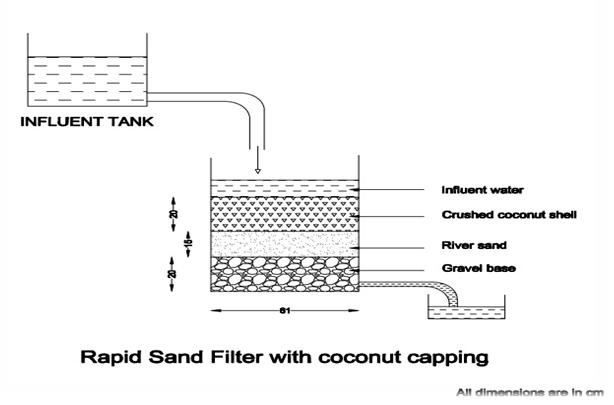





Published on Nov 30, 2023
Rapid sand filter is commonly used in the treatment of surface water supplies. The filter area is divided into at least two separate units to allow operational flexibility. Some form of pre-treatment of the raw water, such as sedimentation, is usually needed. Most of the conventional water treatment plants are overloaded due to increased demand which highlights the need of higher filtration rate. Dual media and multimedia filters can overcome these limitations of rapid sand filters. Alternatively, higher filtration rates even can be achieved. However, the use of such techniques is limited in India due to unavailability of filter materials apart from sand.
Capping of existing rapid sand filters is the promising method of improving the performance of rapid sand filters. Capping is a process of covering the filtration media by appropriates caps such as Anthracite coal, Bituminous coal, Crushed coconut shells, etc.
Capping involves the replacement of a portion of the sand with appropriate caps. Such an improved filter, though inferior to the originally designed dual media filter, is better than the conventional Rapid Sand Filters from the point of view of the rate of filtration as well as total filter run. The proposed study was made to assess the use of coconut shell as a capping media.
Keywords : Rapid sand filter, coconut shells, filtration.
1. To Design and construct pilot scale model of rapid sand filter.
2. To study the performance of coconut shell as filter media.
3. To study the performance of rapid sand filter based on the quality of effluent produced.
In this chapter, testing facilities, experimental procedures and experimental programs are included. Design of experimental set up is done based on the basic design of rapid sand filtration. As per the literature review the design for set-up is done. The fig shows the experimental setup of rapid sand filter with coconut capping.

The following procedure was adopted for conducting the test.
1. Filter layer consisting of gravel bed of 20cm thickness, sand layer of 15cm thickness and crushed coconut shell layer of 20cm thickness was spread in the filter unit.
2. The water obtained from the lake was stored in a large container for a detention period of about 3-4 hours. The supernatant water after sedimentation process was passed through rapid sand filter.
3. Influent water is fed into the filter with the help of a dispenser of 20 liters Capacity has been placed well above the filter unit.
4. A head of water above the filter media in the filtration unit of 10cm was maintained throughout the test period. The raw water was fed to filtration unit continuously through dispenser placed above the filtration unit.
5. Influent and effluent samples were taken at a frequency of every 2 hours. These samples are tested for turbidity, pH, total solids, BOD and COD.
6. The experiment has been carried out up to 24 hours.
7. The following procedures were adopted to test the water samples in the laboratory
During the filtration process Influent and effluent water sample was tested for various parameters like turbidity, pH total solids and BOD and COD. Every 2 hours during the filtration process the effluent and influent samples were collected and then tested. The pH of the effluent sample varied from 2 hours to 14 hours in a decreasing order and further started increasing. The pH of the effluent sample varied from 2 hours to 14 hours in a decreasing order and further started increasing.
The turbidity of the effluent and influent samples were tested in the laboratory using Nephelo-turbidity meter. The filter with coconut capping performed consistently better and achieved as low as 4.9 NTU effluent. The percentage reduction in total solids was found to be 93%. The filter showed good efficiency in the removal of total solids.
1. To study the life span of coconut shells.
2. To make the filtration process more affordable.
3. To study the removal of other parameters like fluoride, iron, manganese etc.
4. To study the backwashing of filters and head loss characteristics.